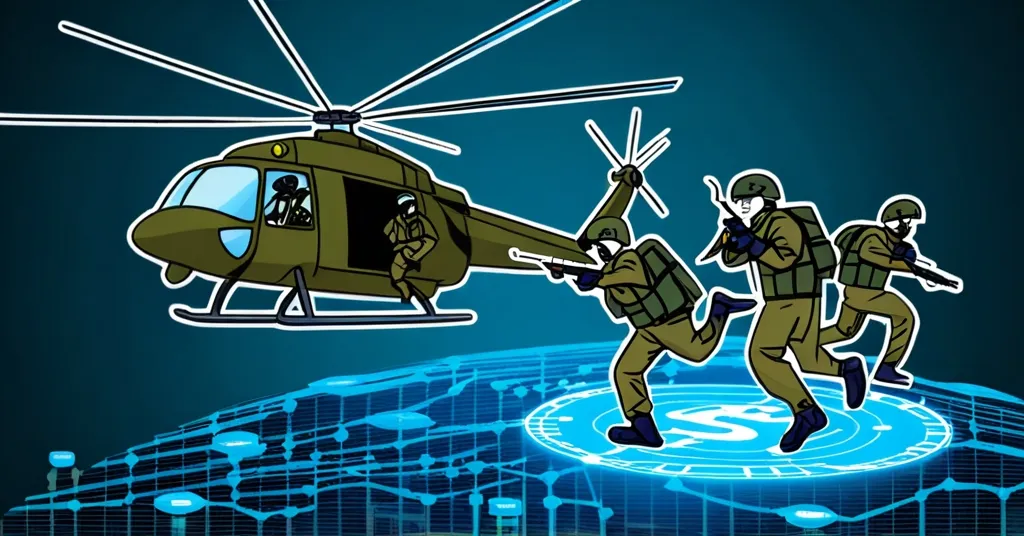Groom Lake’s CEO on Military-Grade Security: Protecting Web3 from Sophisticated Threats

Groom Lake’s Fernando Reyes Jr. on Why Web3 Needs Military-Grade Security
Fernando Reyes Jr., the founder and CEO of Groom Lake, a private military corporation focused on Web3 security, stresses the urgent need for military-grade protections in the cryptocurrency sector. Groom Lake aims to combat sophisticated cyber threats, from solo hackers to state-sponsored entities like North Korea’s Lazarus Group, by deploying former US military and intelligence operatives worldwide to respond rapidly to security incidents.
- Groom Lake’s mission to protect Web3
- Operations Ural Spectre and Wavefront
- 24-hour global response capabilities
- Utilizing OSINT and blockchain forensics
- Safeguarding VIPs and whales
- Security best practices and cold case challenges
Groom Lake isn’t just another security firm; it’s the crypto world’s SWAT team. With operations like Ural Spectre, they’ve unearthed Lazarus Group’s tactics in the Russian Far East, revealing the global reach of these cyber threats. When it comes to protecting digital assets, time is the enemy. Reyes Jr. puts it bluntly: “Time is critical in incident response – the longer the victim delays actions, the more likely it is they’ll suffer permanent fund loss or collateral damage.” Within 24 hours, Groom Lake can deploy operatives anywhere in the world, racing against the clock to recover funds and thwart attackers.
Their approach combines Open Source Intelligence (OSINT), which involves gathering information from publicly available sources, with blockchain forensics to track down cybercriminals. This method was showcased in Operation Wavefront, where they traced a developer who minted and sold new tokens, demonstrating the effectiveness of their investigative prowess.
But it’s not just about protecting Web3 protocols; Groom Lake also shields high-profile individuals, or “crypto whales,” from traditional threats like phishing, which involves tricking people into revealing sensitive information, and SIM swaps, where attackers take over a victim’s phone number to access their accounts. Their proprietary tool, REAPER, delivers real-time threat intelligence feeds, essential in the ongoing battle against cybercriminals.
Reyes Jr. advocates for building security into the very DNA of Web3 projects. “Universal security should be built in as you go… Key measures include implementing multi-factor authentication (MFA) through authenticator apps,” he suggests. MFA adds an extra layer of security by requiring more than one method of verification before granting access. Other crucial practices include verifying links before clicking, conducting regular access audits, and applying the principle of least privilege (POLP), which means giving users only the access they need for their tasks.
Yet, even with these measures, challenges persist. Cold cases and highly anonymized attacks remain difficult to crack. Groom Lake tackles these by collaborating with law enforcement and international agencies like INTERPOL, adhering to rigorous intelligence analysis standards like ICD 203, which are used in the U.S. intelligence community to ensure thorough and effective investigations. “At Groom Lake, we utilize the same analytic standards and processes used in the U.S. intelligence community, specifically ICD 203,” Reyes Jr. explains.
In the world of cryptocurrency, where the stakes are high and threats are sophisticated, Groom Lake’s approach to Web3 security isn’t just about defense—it’s about taking the fight to the enemy and ensuring the future of decentralized technology remains secure and resilient.
Key Takeaways and Questions
- Why is military-grade security necessary for Web3 companies and protocols?
Military-grade security is essential because Web3 companies and protocols face threats from sophisticated hackers and state-backed groups like the Lazarus Group, requiring a high level of expertise and rapid response to counteract effectively.
- How does Groom Lake respond to security incidents, and why is speed crucial?
Groom Lake responds to security incidents by deploying operatives worldwide within 24 hours. Speed is crucial because it increases the likelihood of recovering stolen funds and catching perpetrators before they can cover their tracks.
- What methods does Groom Lake use to track down hackers, and how effective are these methods?
Groom Lake uses a combination of Open Source Intelligence (OSINT) and blockchain forensics to identify and track hackers. These methods have proven effective in operations like Operation Wavefront, allowing the company to reach key conclusions and deploy operatives quickly.
- How does Groom Lake protect VIPs and whales from security threats?
Groom Lake protects VIPs and whales using proprietary tools like REAPER to monitor threats in real-time and by providing rapid-response services to recover assets and mitigate risks from traditional security threats like phishing and SIM swaps.
- What are some recommended security best practices for Web3 protocols and high-profile individuals?
Recommended security best practices include implementing multi-factor authentication (MFA) through authenticator apps, verifying links before clicking, conducting regular access audits, enforcing the principle of least privilege (POLP), and safeguarding digital assets with additional security measures.
- What challenges does Groom Lake face in investigating cybercrimes, and how do they address these challenges?
Challenges include cold cases and highly anonymized attacks. Groom Lake addresses these challenges by collaborating with law enforcement and international agencies like INTERPOL and by adhering to rigorous intelligence analysis standards like ICD 203.



